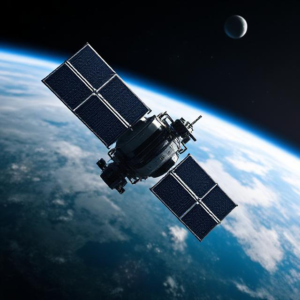1. What is a Low Earth Orbit (LEO)?
Low Earth Orbit (LEO) refers to a region of space where satellites orbit the Earth relatively close to the surface, typically at altitudes ranging from about 100 to 1,200 miles (160 to 2,000 kilometers). For comparison, Geostationary Orbit (GEO) satellites are much farther away, around 22,000 miles (35,000 km) above the Earth.
Because LEO satellites are much closer to Earth, they have certain advantages for communication.

2. How Do LEO Satellites Work?
LEO satellites are small spacecraft that move very fast, orbiting the Earth in roughly 90 to 120 minutes (that’s how long it takes for them to complete one full orbit). As they move, they pass over different areas of the Earth, and each satellite can provide coverage to specific regions on the planet.
Here’s how it works:
- Communication signals: When you send a signal, like from a mobile phone or an internet router, the signal is sent up to a LEO satellite overhead.
- The satellite then relays the signal to a ground station on Earth or another satellite.
- Fast response: Since LEO satellites are closer to Earth, the signal travel time is much shorter, leading to less delay (also called latency).
3. Why Use LEO Satellites for Communication?
Here are some key benefits of using LEO satellites for communication:
a. Lower Latency (Faster Communication)
- Because LEO satellites are much closer to Earth, the time it takes for signals to travel is faster compared to satellites in higher orbits like GEO.
- This low latency is great for applications that require quick responses, like video calls, online gaming, and real-time internet browsing.
b. Better Coverage
- LEO satellites can provide more frequent coverage of different areas on Earth because they orbit quickly and cover smaller regions at a time.
- When one satellite moves out of view, another one takes its place to maintain continuous coverage.
c. Smaller and Cheaper Satellites
- LEO satellites are smaller and lighter compared to those in higher orbits, so they are generally cheaper to build and launch.
d. Global Communication
- With a network of LEO satellites, you can achieve global communication coverage, even in remote areas like oceans or rural regions, where traditional ground-based networks (like cell towers or fiber optic cables) might not be available.
4. Challenges with LEO Satellites
Although LEO satellites offer many benefits, there are a few challenges:
a. Limited Coverage Per Satellite
- Each LEO satellite can only cover a small area of the Earth at one time. However, by using many LEO satellites in a constellation (a large group of satellites), you can provide continuous global coverage.
b. Frequent Satellite Replacement
- Since LEO satellites are in low orbit, they are subject to atmospheric drag (resistance from the Earth’s atmosphere), which causes them to gradually lose altitude and eventually fall back to Earth. So, they have a shorter lifespan than GEO satellites (around 5-10 years), and new satellites need to be launched regularly.
c. Signal Interference
- LEO satellites can experience more signal interference from weather conditions, such as clouds or storms, because they’re closer to the atmosphere.
5. Examples of LEO Satellite Networks for Communication
There are some well-known satellite constellations that are designed to provide global communication through LEO satellites:
a. Starlink (by SpaceX)
- Starlink is one of the most popular LEO satellite constellations. It’s being built by SpaceX to provide high-speed internet to underserved areas around the world, especially in rural or remote regions.
- The network will have thousands of LEO satellites working together to provide reliable and fast internet access.
b. OneWeb
- OneWeb is another company aiming to provide global broadband internet using a constellation of LEO satellites.
- They’re also focused on helping people in remote and rural locations where traditional internet infrastructure is hard to build.
c. Amazon’s Project Kuiper
- Project Kuiper is Amazon’s planned satellite network, which will also consist of LEO satellites providing internet service to homes and businesses around the world.
6. Applications of LEO Satellites for Communication
LEO satellites can support a wide range of communication services, including:
- Internet access in remote or rural areas (for homes, schools, and businesses).
- Global 5G connectivity to support faster mobile internet on a global scale.
- Disaster recovery: LEO satellites can provide communication support in places where the local infrastructure is damaged by natural disasters.
- Military and government communication: LEO satellites are often used by governments for secure and reliable communication.
- Real-time services like video conferencing, online gaming, and streaming, where low latency is critical.
7. Future of LEO Satellites
The use of LEO satellites for communication is expected to grow significantly in the coming years:
- More satellites: Thousands of LEO satellites are expected to be launched into space in the near future, improving global connectivity.
- Better performance: As technology improves, we will likely see even faster speeds, better coverage, and more reliable connections from LEO satellites.
Conclusion
In simple terms, Low Earth Orbit (LEO) satellites are a new and exciting way to provide fast, reliable global communication. They have lower latency, cost less to launch, and can offer internet and communication services in areas where traditional infrastructure is difficult to set up. Companies like SpaceX with Star link are already working to deploy large networks of LEO satellites to help bridge the digital divide and bring internet access to everyone, no matter where they live.











